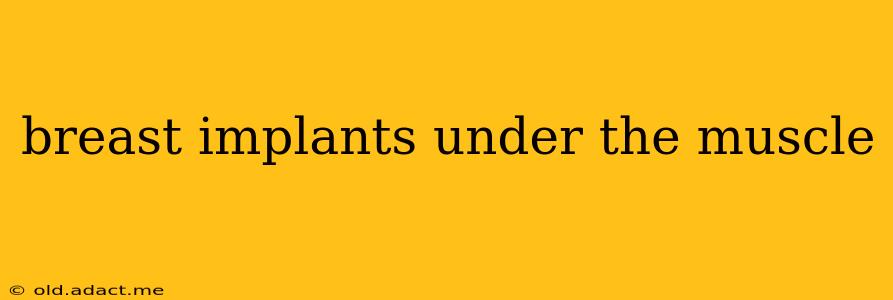Choosing the right breast augmentation procedure is a deeply personal decision. One crucial element is the placement of the implants: under the muscle (submuscular) or on top of the muscle (subglandular). This article focuses on submuscular breast implant placement, exploring its benefits, potential drawbacks, and frequently asked questions.
What are the benefits of placing breast implants under the muscle?
Placing breast implants under the pectoralis major muscle offers several advantages. One significant benefit is improved cosmetic results. The muscle provides a natural covering, potentially reducing the visibility of implant edges or ripples, particularly in women with thinner breast tissue. This leads to a smoother, more natural-looking breast contour. Additionally, submuscular placement may offer better protection for the implants, reducing the risk of capsular contracture (hardening and tightening of the scar tissue around the implant), a common complication although not exclusive to this placement. Finally, some patients feel the implants are better hidden and less noticeable under the muscle layer.
What are the potential risks and downsides of putting breast implants under the muscle?
While offering many benefits, submuscular placement also has potential drawbacks. The most significant is the increased surgical time and potential for greater post-operative pain and discomfort. This is because the surgeon needs to carefully dissect and separate the muscle fibers to create a pocket for the implant. This extensive surgery can also lead to more pronounced bruising and swelling in the initial recovery period. Additionally, the muscle may compress the implant initially, leading to a feeling of firmness that will subside over time. Finally, it's important to note that no placement is entirely without the risk of complications like infection, seroma formation (fluid collection), or implant rupture—risks that exist regardless of placement location.
How long is the recovery time after getting breast implants placed under the muscle?
Recovery time varies significantly between individuals, depending on factors such as surgical technique, individual healing capacity, and adherence to post-operative care instructions. Generally, expect a longer recovery period for submuscular placement compared to subglandular placement. Expect increased pain, swelling, and bruising in the initial weeks. Most patients can return to light activities within a few weeks, but strenuous activity and heavy lifting are generally discouraged for several months. Full recovery, including the resolution of all swelling and the settling of the implants, can take several months or even up to a year. Close follow-up appointments with the surgeon are crucial to monitor healing progress and address any concerns.
Does placing breast implants under the muscle make them feel harder?
Initially, the implants may feel firmer due to the compression of the overlying muscle. However, as the muscle adjusts and the swelling subsides over time, this firmness typically diminishes, resulting in a softer feel. The final feel is also influenced by the type of implant used (saline or silicone) and the implant's characteristics (shape, texture, and volume). It's important to communicate openly with your surgeon about your expectations regarding implant feel and to understand that the initial experience might not be representative of the long-term result.
Are there specific types of breast implants better suited for placement under the muscle?
While both saline and silicone implants can be placed under the muscle, the choice often depends on individual factors, such as breast tissue characteristics and patient preferences. Your surgeon will consider these factors when recommending the most appropriate implant type. Furthermore, the implant's texture (smooth or textured) and shape (round or anatomical) will also play a role in the overall outcome and suitability for submuscular placement. The specific recommendations will be based on a thorough consultation and examination.
What is the difference between submuscular and subglandular breast implant placement?
The primary difference lies in the location of the implant. Submuscular placement positions the implant beneath the pectoralis major muscle, while subglandular placement places it on top of the muscle, directly beneath the breast tissue. This difference significantly impacts the recovery process, potential complications, and the overall aesthetic outcome. Submuscular placement often offers better concealment and a smoother contour but comes with a longer recovery period and increased post-operative discomfort. Subglandular placement is typically associated with a faster recovery but might result in a less natural-looking outcome for some patients. The optimal placement depends on individual factors and should be determined during consultation with a qualified plastic surgeon.
Disclaimer: This information is for educational purposes only and should not be considered medical advice. Always consult with a qualified plastic surgeon to discuss your individual needs and determine the best course of action for your breast augmentation procedure.
